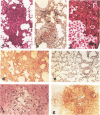Abstract
Immunoglobulin G1 (IgG1) monoclonal antibodies (MAbs) to the capsular glucuronoxylomannan (GXM) were studied for their ability to modify the course of intravenous Cryptococcus neoformans infection in mice. A/J mice were given intraperitoneal injection of 1.0 mg of either a GXM-binding IgG1 MAb (2H1 or 2D10 gamma 1) or the irrelevant isotype-matched control MAb 36-65 prior to intravenous infection. Parameters used to study antibody efficacy were lung and brain tissue fungal burden, lung and brain weights, serum GXM levels, and histopathological examination of lung, brain, heart, kidney, and spleen tissues. Mice given GXM-binding MAb had significantly reduced lung tissue fungal burden as measured by CFU. In contrast to the reduction in lung tissue burden, the reduction in brain tissue burden was small and did not achieve statistical significance. Serum GXM levels were reduced in mice receiving GXM-binding MAb. Histopathological examination revealed reduced numbers of granulomas and C. neoformans organisms in the lungs, brains, and kidneys of MAb 2H1-treated mice relative to control mice. The lungs and brains of mice receiving GXM-binding MAb weighed significantly less than those of control animals, consistent with the reduced inflammation noted histologically. Subendocardial inflammation and kidney cortical infarctions were present in control infected mice but not in MAb 2H1-treated mice. Immunocytochemical staining for polysaccharide antigen revealed a marked reduction in the amount of tissue polysaccharide in mice treated with MAb 2H1 relative to control mice. The results support an useful role for passive antibody administration in C. neoformans infections.
Full text
PDF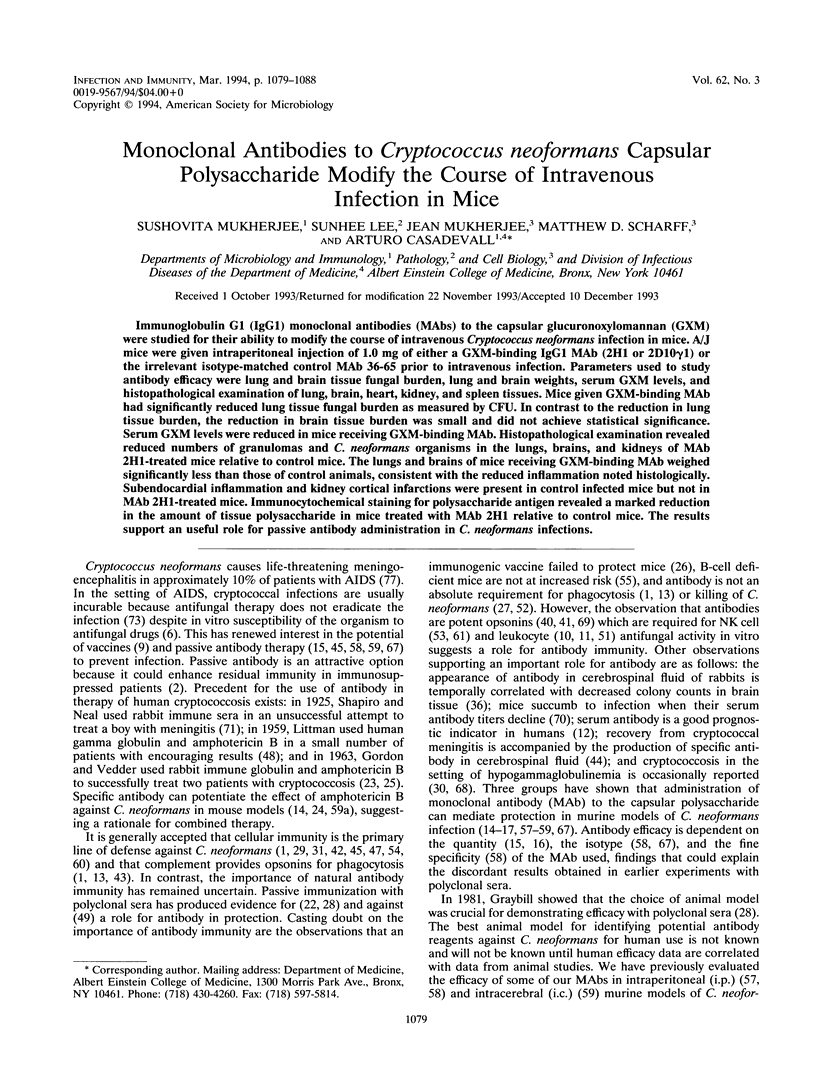
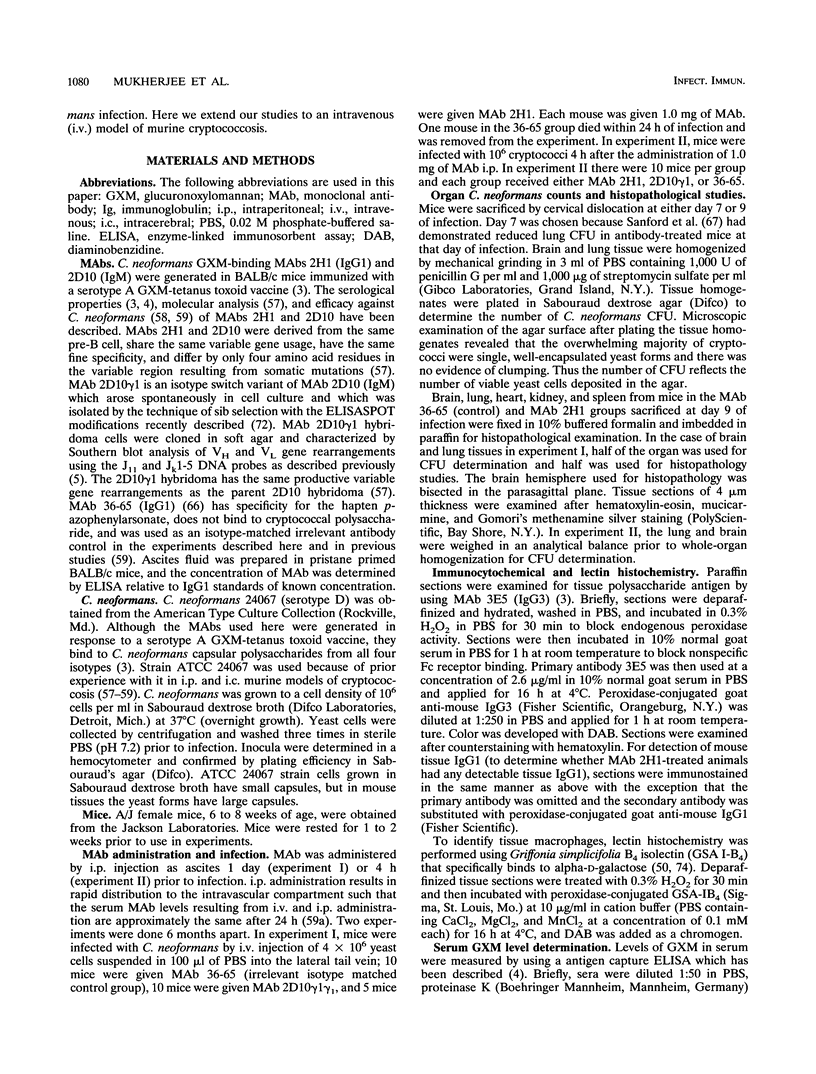
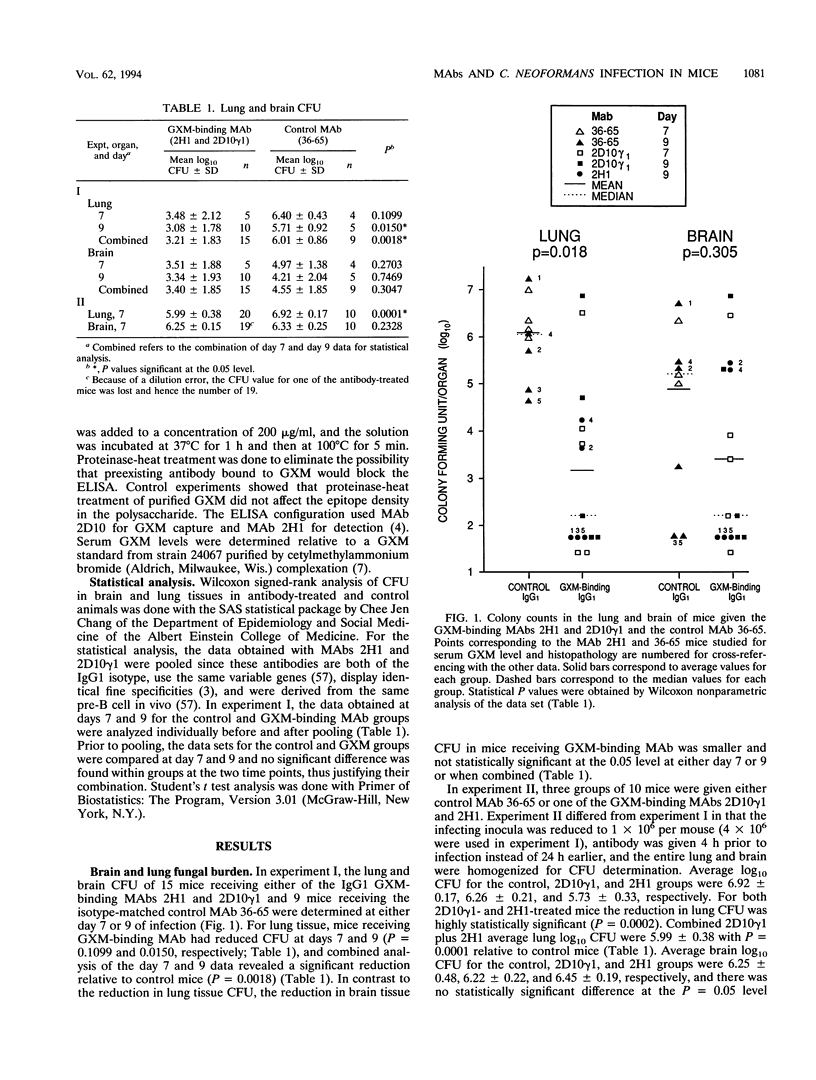
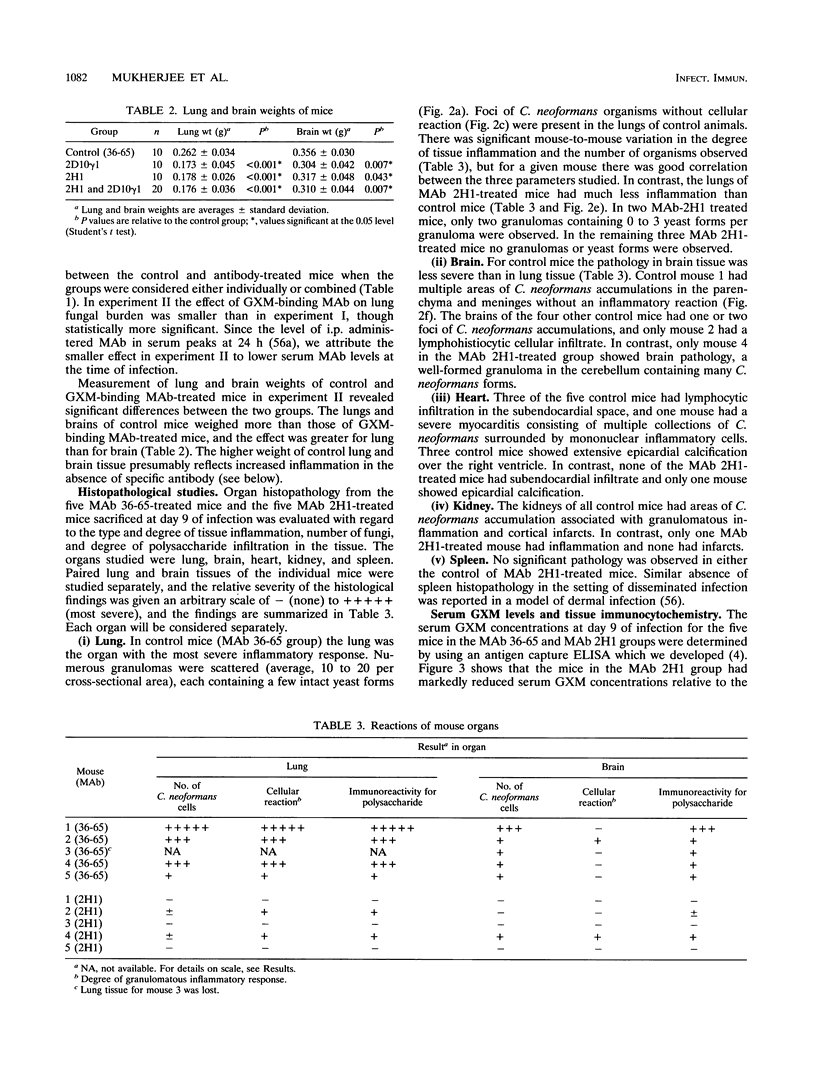
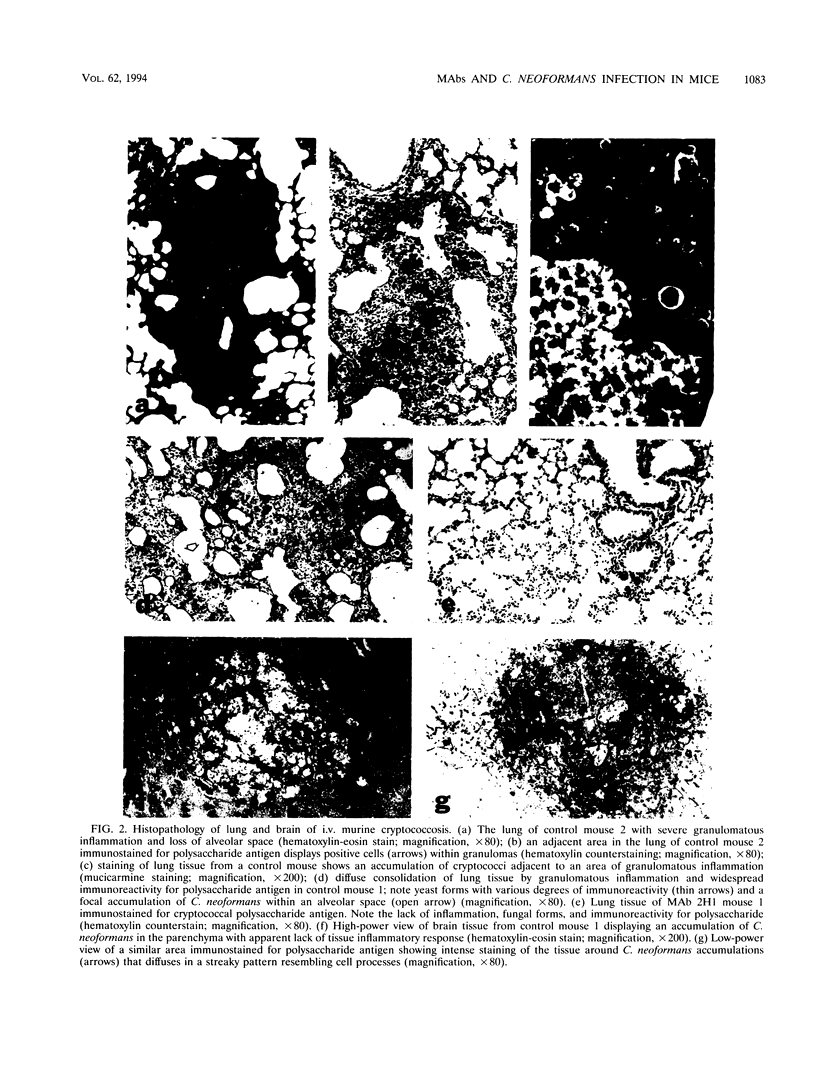
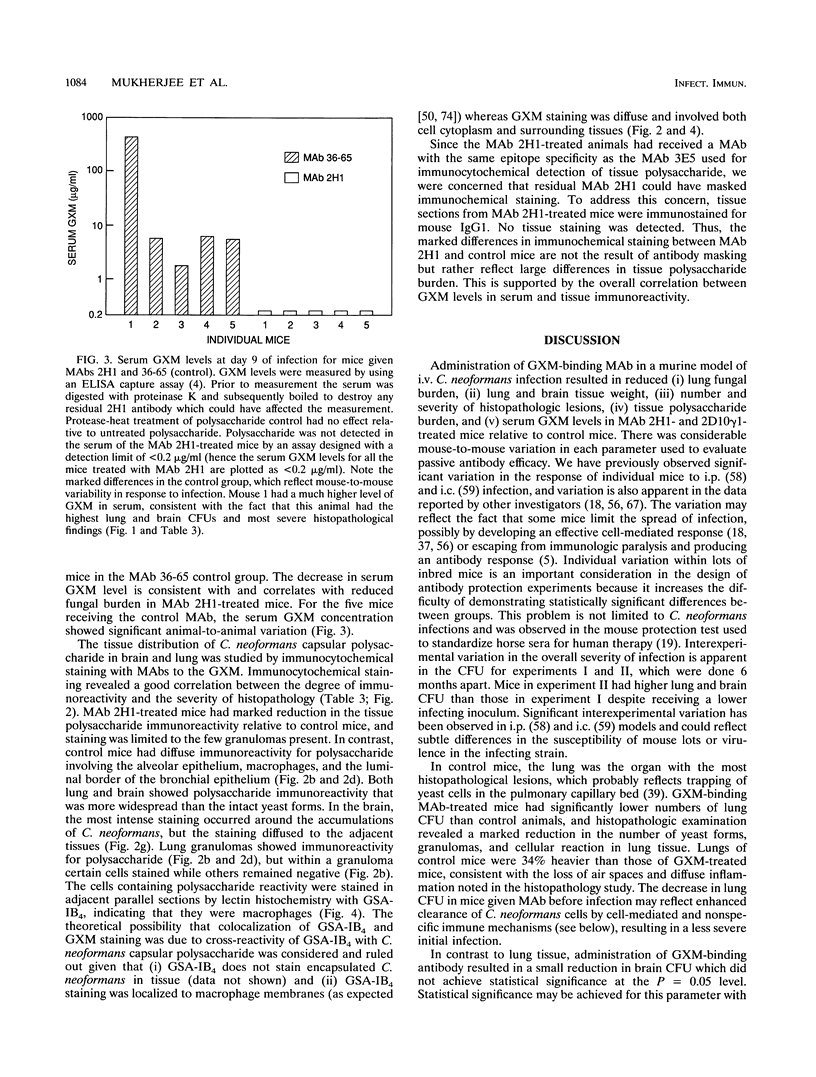
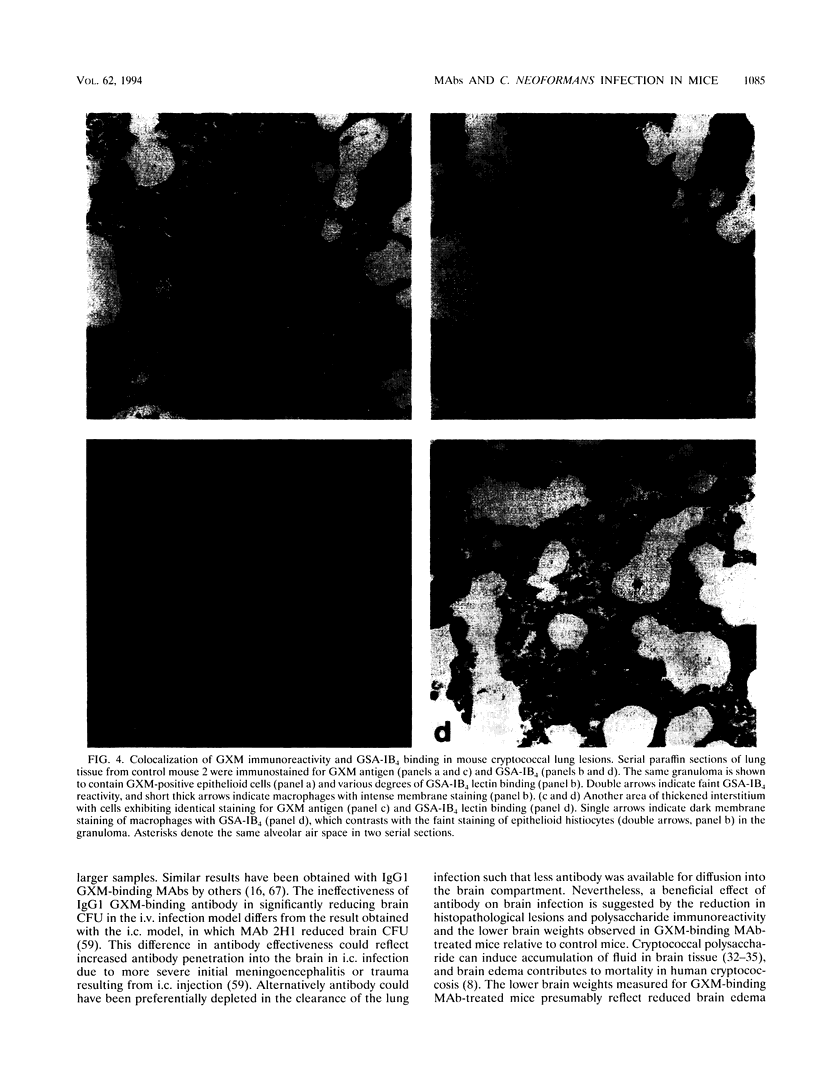
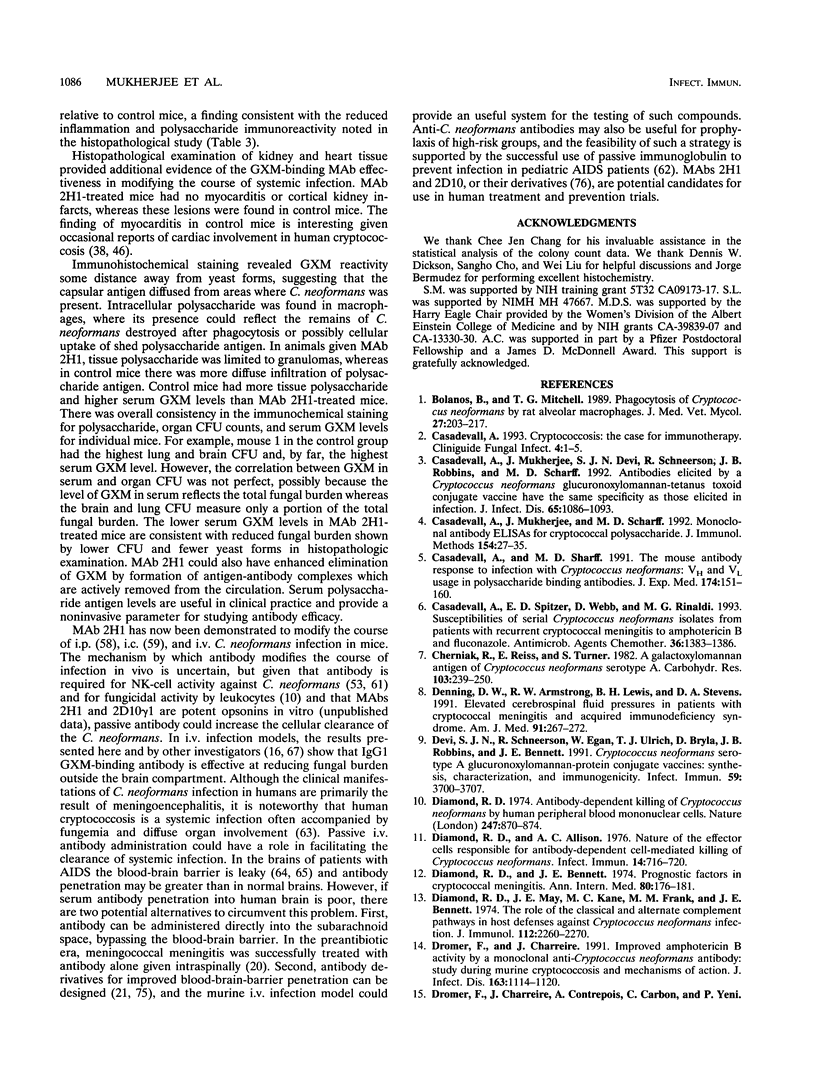
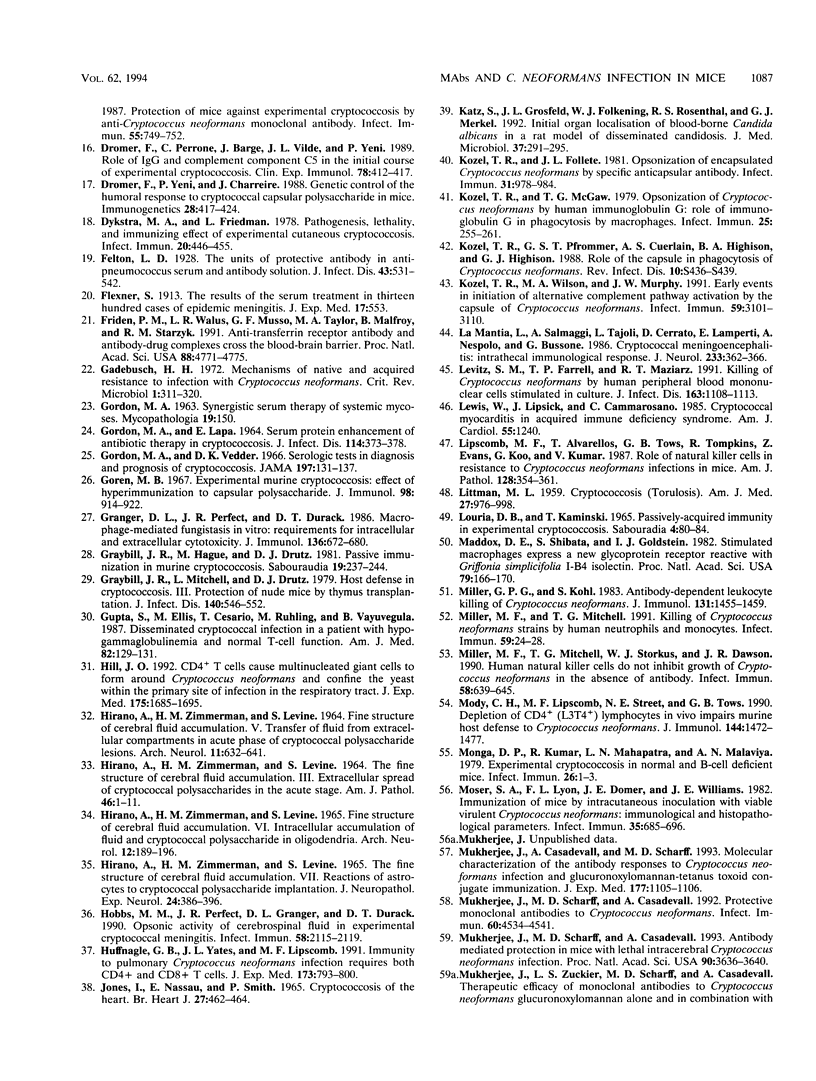
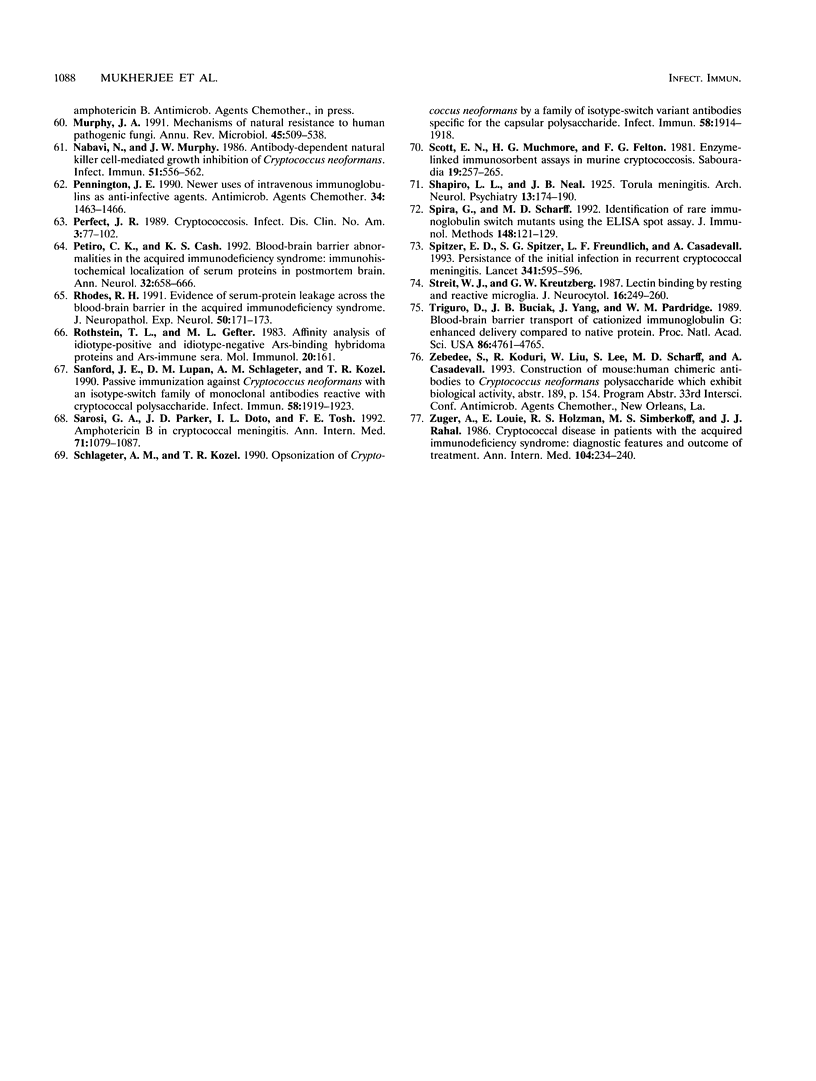
Images in this article
Selected References
These references are in PubMed. This may not be the complete list of references from this article.
- Bolaños B., Mitchell T. G. Phagocytosis of Cryptococcus neoformans by rat alveolar macrophages. J Med Vet Mycol. 1989;27(4):203–217. [PubMed] [Google Scholar]
- Casadevall A., Mukherjee J., Devi S. J., Schneerson R., Robbins J. B., Scharff M. D. Antibodies elicited by a Cryptococcus neoformans-tetanus toxoid conjugate vaccine have the same specificity as those elicited in infection. J Infect Dis. 1992 Jun;165(6):1086–1093. doi: 10.1093/infdis/165.6.1086. [DOI] [PubMed] [Google Scholar]
- Casadevall A., Mukherjee J., Scharff M. D. Monoclonal antibody based ELISAs for cryptococcal polysaccharide. J Immunol Methods. 1992 Sep 18;154(1):27–35. doi: 10.1016/0022-1759(92)90209-c. [DOI] [PubMed] [Google Scholar]
- Casadevall A., Scharff M. D. The mouse antibody response to infection with Cryptococcus neoformans: VH and VL usage in polysaccharide binding antibodies. J Exp Med. 1991 Jul 1;174(1):151–160. doi: 10.1084/jem.174.1.151. [DOI] [PMC free article] [PubMed] [Google Scholar]
- Casadevall A., Spitzer E. D., Webb D., Rinaldi M. G. Susceptibilities of serial Cryptococcus neoformans isolates from patients with recurrent cryptococcal meningitis to amphotericin B and fluconazole. Antimicrob Agents Chemother. 1993 Jun;37(6):1383–1386. doi: 10.1128/aac.37.6.1383. [DOI] [PMC free article] [PubMed] [Google Scholar]
- Denning D. W., Armstrong R. W., Lewis B. H., Stevens D. A. Elevated cerebrospinal fluid pressures in patients with cryptococcal meningitis and acquired immunodeficiency syndrome. Am J Med. 1991 Sep;91(3):267–272. doi: 10.1016/0002-9343(91)90126-i. [DOI] [PubMed] [Google Scholar]
- Devi S. J., Schneerson R., Egan W., Ulrich T. J., Bryla D., Robbins J. B., Bennett J. E. Cryptococcus neoformans serotype A glucuronoxylomannan-protein conjugate vaccines: synthesis, characterization, and immunogenicity. Infect Immun. 1991 Oct;59(10):3700–3707. doi: 10.1128/iai.59.10.3700-3707.1991. [DOI] [PMC free article] [PubMed] [Google Scholar]
- Diamond R. D., Allison A. C. Nature of the effector cells responsible for antibody-dependent cell-mediated killing of Cryptococcus neoformans. Infect Immun. 1976 Sep;14(3):716–720. doi: 10.1128/iai.14.3.716-720.1976. [DOI] [PMC free article] [PubMed] [Google Scholar]
- Diamond R. D., Bennett J. E. Prognostic factors in cryptococcal meningitis. A study in 111 cases. Ann Intern Med. 1974 Feb;80(2):176–181. doi: 10.7326/0003-4819-80-2-176. [DOI] [PubMed] [Google Scholar]
- Diamond R. D., May J. E., Kane M. A., Frank M. M., Bennett J. E. The role of the classical and alternate complement pathways in host defenses against Cryptococcus neoformans infection. J Immunol. 1974 Jun;112(6):2260–2270. [PubMed] [Google Scholar]
- Dromer F., Charreire J., Contrepois A., Carbon C., Yeni P. Protection of mice against experimental cryptococcosis by anti-Cryptococcus neoformans monoclonal antibody. Infect Immun. 1987 Mar;55(3):749–752. doi: 10.1128/iai.55.3.749-752.1987. [DOI] [PMC free article] [PubMed] [Google Scholar]
- Dromer F., Charreire J. Improved amphotericin B activity by a monoclonal anti-Cryptococcus neoformans antibody: study during murine cryptococcosis and mechanisms of action. J Infect Dis. 1991 May;163(5):1114–1120. doi: 10.1093/infdis/163.5.1114. [DOI] [PubMed] [Google Scholar]
- Dromer F., Perronne C., Barge J., Vilde J. L., Yeni P. Role of IgG and complement component C5 in the initial course of experimental cryptococcosis. Clin Exp Immunol. 1989 Dec;78(3):412–417. [PMC free article] [PubMed] [Google Scholar]
- Dromer F., Yeni P., Charreire J. Genetic control of the humoral response to cryptococcal capsular polysaccharide in mice. Immunogenetics. 1988;28(6):417–424. doi: 10.1007/BF00355373. [DOI] [PubMed] [Google Scholar]
- Dykstra M. A., Friedman L. Pathogenesis, lethality, and immunizing effect of experimental cutaneous cryptococcosis. Infect Immun. 1978 May;20(2):446–455. doi: 10.1128/iai.20.2.446-455.1978. [DOI] [PMC free article] [PubMed] [Google Scholar]
- Friden P. M., Walus L. R., Musso G. F., Taylor M. A., Malfroy B., Starzyk R. M. Anti-transferrin receptor antibody and antibody-drug conjugates cross the blood-brain barrier. Proc Natl Acad Sci U S A. 1991 Jun 1;88(11):4771–4775. doi: 10.1073/pnas.88.11.4771. [DOI] [PMC free article] [PubMed] [Google Scholar]
- GORDON M. A., LAPA E. SERUM PROTEIN ENHANCEMENT OF ANTIBIOTIC THERAPY IN CRYPTOCOCCOSIS. J Infect Dis. 1964 Oct;114:373–377. doi: 10.1093/infdis/114.4.373. [DOI] [PubMed] [Google Scholar]
- Goren M. B. Experimental murine cryptococcosis: effect of hyperimmunization to capsular polysaccharide. J Immunol. 1967 May;98(5):914–922. [PubMed] [Google Scholar]
- Granger D. L., Perfect J. R., Durack D. T. Macrophage-mediated fungistasis in vitro: requirements for intracellular and extracellular cytotoxicity. J Immunol. 1986 Jan;136(2):672–680. [PubMed] [Google Scholar]
- Graybill J. R., Hague M., Drutz D. J. Passive immunization in murine cryptococcosis. Sabouraudia. 1981 Dec;19(4):237–244. doi: 10.1080/00362178185380411. [DOI] [PubMed] [Google Scholar]
- Graybill J. R., Mitchell L., Drutz D. J. Host defense in cryptococcosis. III. Protection of nude mice by thymus transplantation. J Infect Dis. 1979 Oct;140(4):546–552. doi: 10.1093/infdis/140.4.546. [DOI] [PubMed] [Google Scholar]
- Gupta S., Ellis M., Cesario T., Ruhling M., Vayuvegula B. Disseminated cryptococcal infection in a patient with hypogammaglobulinemia and normal T cell functions. Am J Med. 1987 Jan;82(1):129–131. doi: 10.1016/0002-9343(87)90388-3. [DOI] [PubMed] [Google Scholar]
- HIRANO A., ZIMMERMAN H. M., LEVINE S. FINE STRUCTURE OF CEREBRAL FLUID ACCUMULATION. V. TRANSFER OF FLUID FROM EXTRACELLULAR TO INTRACELLULAR COMPARTMENTS IN ACUTE PHASE OF CRYPTOCOCCAL POLYSACCHARIDE LESIONS. Arch Neurol. 1964 Dec;11:632–641. doi: 10.1001/archneur.1964.00460240064009. [DOI] [PubMed] [Google Scholar]
- HIRANO A., ZIMMERMAN H. M., LEVINE S. FINE STRUCTURE OF CEREBRAL FLUID ACCUMULATION. VI. INTRACELLULAR ACCUMULATION OF FLUID AND CRYPTOCOCCAL POLYSACCHARIDE IN OLIGODENDROGLIA. Arch Neurol. 1965 Feb;12:189–196. doi: 10.1001/archneur.1965.00460260079009. [DOI] [PubMed] [Google Scholar]
- HIRANO A., ZIMMERMAN H. M., LEVINE S. THE FINE STRUCTURE OF CEREBRAL FLUID ACCUMULATION. III. EXTRACELLULAR SPREAD OF CRYPTOCOCCAL POLYSACCHARIDES IN THE ACUTE STAGE. Am J Pathol. 1964 Jul;45:1–19. [PMC free article] [PubMed] [Google Scholar]
- Hill J. O. CD4+ T cells cause multinucleated giant cells to form around Cryptococcus neoformans and confine the yeast within the primary site of infection in the respiratory tract. J Exp Med. 1992 Jun 1;175(6):1685–1695. doi: 10.1084/jem.175.6.1685. [DOI] [PMC free article] [PubMed] [Google Scholar]
- Hobbs M. M., Perfect J. R., Granger D. L., Durack D. T. Opsonic activity of cerebrospinal fluid in experimental cryptococcal meningitis. Infect Immun. 1990 Jul;58(7):2115–2119. doi: 10.1128/iai.58.7.2115-2119.1990. [DOI] [PMC free article] [PubMed] [Google Scholar]
- Huffnagle G. B., Yates J. L., Lipscomb M. F. Immunity to a pulmonary Cryptococcus neoformans infection requires both CD4+ and CD8+ T cells. J Exp Med. 1991 Apr 1;173(4):793–800. doi: 10.1084/jem.173.4.793. [DOI] [PMC free article] [PubMed] [Google Scholar]
- JONES I., NASSAU E., SMITH P. CRYPTOCOCCOSIS OF THE HEART. Br Heart J. 1965 May;27:462–464. doi: 10.1136/hrt.27.3.462. [DOI] [PMC free article] [PubMed] [Google Scholar]
- Katz S., Grosfeld J. L., Folkening W. J., Rosenthal R. S., Merkel G. J. Initial organ localisation of blood-borne Candida albicans in a rat model of disseminated candidosis. J Med Microbiol. 1992 Oct;37(4):291–295. doi: 10.1099/00222615-37-4-291. [DOI] [PubMed] [Google Scholar]
- Kozel T. R., Follette J. L. Opsonization of encapsulated Cryptococcus neoformans by specific anticapsular antibody. Infect Immun. 1981 Mar;31(3):978–984. doi: 10.1128/iai.31.3.978-984.1981. [DOI] [PMC free article] [PubMed] [Google Scholar]
- Kozel T. R., McGaw T. G. Opsonization of Cryptococcus neoformans by human immunoglobulin G: role of immunoglobulin G in phagocytosis by macrophages. Infect Immun. 1979 Jul;25(1):255–261. doi: 10.1128/iai.25.1.255-261.1979. [DOI] [PMC free article] [PubMed] [Google Scholar]
- Kozel T. R., Pfrommer G. S., Guerlain A. S., Highison B. A., Highison G. J. Role of the capsule in phagocytosis of Cryptococcus neoformans. Rev Infect Dis. 1988 Jul-Aug;10 (Suppl 2):S436–S439. doi: 10.1093/cid/10.supplement_2.s436. [DOI] [PubMed] [Google Scholar]
- Kozel T. R., Wilson M. A., Murphy J. W. Early events in initiation of alternative complement pathway activation by the capsule of Cryptococcus neoformans. Infect Immun. 1991 Sep;59(9):3101–3110. doi: 10.1128/iai.59.9.3101-3110.1991. [DOI] [PMC free article] [PubMed] [Google Scholar]
- LITTMAN M. L. Cryptococcosis (torulosis). Current concepts and therapy. Am J Med. 1959 Dec;27:976–998. doi: 10.1016/0002-9343(59)90181-0. [DOI] [PubMed] [Google Scholar]
- La Mantia L., Salmaggi A., Tajoli L., Cerrato D., Lamperti E., Nespolo A., Bussone G. Cryptococcal meningoencephalitis: intrathecal immunological response. J Neurol. 1986 Nov;233(6):362–366. doi: 10.1007/BF00313923. [DOI] [PubMed] [Google Scholar]
- Levitz S. M., Farrell T. P., Maziarz R. T. Killing of Cryptococcus neoformans by human peripheral blood mononuclear cells stimulated in culture. J Infect Dis. 1991 May;163(5):1108–1113. doi: 10.1093/infdis/163.5.1108. [DOI] [PubMed] [Google Scholar]
- Lewis W., Lipsick J., Cammarosano C. Cryptococcal myocarditis in acquired immune deficiency syndrome. Am J Cardiol. 1985 Apr 15;55(9):1240–1240. doi: 10.1016/0002-9149(85)90680-0. [DOI] [PubMed] [Google Scholar]
- Lipscomb M. F., Alvarellos T., Toews G. B., Tompkins R., Evans Z., Koo G., Kumar V. Role of natural killer cells in resistance to Cryptococcus neoformans infections in mice. Am J Pathol. 1987 Aug;128(2):354–361. [PMC free article] [PubMed] [Google Scholar]
- Louria D. B., Kaminski T. Passively-acquired immunity in experimental cryptococcosis. Sabouraudia. 1965 Jun;4(2):80–84. doi: 10.1080/00362176685190211. [DOI] [PubMed] [Google Scholar]
- Maddox D. E., Shibata S., Goldstein I. J. Stimulated macrophages express a new glycoprotein receptor reactive with Griffonia simplicifolia I-B4 isolectin. Proc Natl Acad Sci U S A. 1982 Jan;79(1):166–170. doi: 10.1073/pnas.79.1.166. [DOI] [PMC free article] [PubMed] [Google Scholar]
- Miller G. P., Kohl S. Antibody-dependent leukocyte killing of Cryptococcus neoformans. J Immunol. 1983 Sep;131(3):1455–1459. [PubMed] [Google Scholar]
- Miller M. F., Mitchell T. G. Killing of Cryptococcus neoformans strains by human neutrophils and monocytes. Infect Immun. 1991 Jan;59(1):24–28. doi: 10.1128/iai.59.1.24-28.1991. [DOI] [PMC free article] [PubMed] [Google Scholar]
- Miller M. F., Mitchell T. G., Storkus W. J., Dawson J. R. Human natural killer cells do not inhibit growth of Cryptococcus neoformans in the absence of antibody. Infect Immun. 1990 Mar;58(3):639–645. doi: 10.1128/iai.58.3.639-645.1990. [DOI] [PMC free article] [PubMed] [Google Scholar]
- Mody C. H., Lipscomb M. F., Street N. E., Toews G. B. Depletion of CD4+ (L3T4+) lymphocytes in vivo impairs murine host defense to Cryptococcus neoformans. J Immunol. 1990 Feb 15;144(4):1472–1477. [PubMed] [Google Scholar]
- Monga D. P., Kumar R., Mohapatra L. N., Malaviya A. N. Experimental cryptococcosis in normal and B-cell-deficient mice. Infect Immun. 1979 Oct;26(1):1–3. doi: 10.1128/iai.26.1.1-3.1979. [DOI] [PMC free article] [PubMed] [Google Scholar]
- Moser S. A., Lyon F. L., Domer J. E., Williams J. E. Immunization of mice by intracutaneous inoculation with viable virulent Cryptococcus neoformans: immunological and histopathological parameters. Infect Immun. 1982 Feb;35(2):685–696. doi: 10.1128/iai.35.2.685-696.1982. [DOI] [PMC free article] [PubMed] [Google Scholar]
- Mukherjee J., Casadevall A., Scharff M. D. Molecular characterization of the humoral responses to Cryptococcus neoformans infection and glucuronoxylomannan-tetanus toxoid conjugate immunization. J Exp Med. 1993 Apr 1;177(4):1105–1116. doi: 10.1084/jem.177.4.1105. [DOI] [PMC free article] [PubMed] [Google Scholar]
- Mukherjee J., Pirofski L. A., Scharff M. D., Casadevall A. Antibody-mediated protection in mice with lethal intracerebral Cryptococcus neoformans infection. Proc Natl Acad Sci U S A. 1993 Apr 15;90(8):3636–3640. doi: 10.1073/pnas.90.8.3636. [DOI] [PMC free article] [PubMed] [Google Scholar]
- Mukherjee J., Scharff M. D., Casadevall A. Protective murine monoclonal antibodies to Cryptococcus neoformans. Infect Immun. 1992 Nov;60(11):4534–4541. doi: 10.1128/iai.60.11.4534-4541.1992. [DOI] [PMC free article] [PubMed] [Google Scholar]
- Murphy J. W. Mechanisms of natural resistance to human pathogenic fungi. Annu Rev Microbiol. 1991;45:509–538. doi: 10.1146/annurev.mi.45.100191.002453. [DOI] [PubMed] [Google Scholar]
- Nabavi N., Murphy J. W. Antibody-dependent natural killer cell-mediated growth inhibition of Cryptococcus neoformans. Infect Immun. 1986 Feb;51(2):556–562. doi: 10.1128/iai.51.2.556-562.1986. [DOI] [PMC free article] [PubMed] [Google Scholar]
- Pennington J. E. Newer uses of intravenous immunoglobulins as anti-infective agents. Antimicrob Agents Chemother. 1990 Aug;34(8):1463–1466. doi: 10.1128/aac.34.8.1463. [DOI] [PMC free article] [PubMed] [Google Scholar]
- Perfect J. R. Cryptococcosis. Infect Dis Clin North Am. 1989 Mar;3(1):77–102. [PubMed] [Google Scholar]
- Petito C. K., Cash K. S. Blood-brain barrier abnormalities in the acquired immunodeficiency syndrome: immunohistochemical localization of serum proteins in postmortem brain. Ann Neurol. 1992 Nov;32(5):658–666. doi: 10.1002/ana.410320509. [DOI] [PubMed] [Google Scholar]
- Rhodes R. H. Evidence of serum-protein leakage across the blood-brain barrier in the acquired immunodeficiency syndrome. J Neuropathol Exp Neurol. 1991 Mar;50(2):171–183. doi: 10.1097/00005072-199103000-00008. [DOI] [PubMed] [Google Scholar]
- Rothstein T. L., Gefter M. L. Affinity analysis of idiotype-positive and idiotype-negative Ars-binding hybridoma proteins and Ars-immune sera. Mol Immunol. 1983 Feb;20(2):161–168. doi: 10.1016/0161-5890(83)90127-x. [DOI] [PubMed] [Google Scholar]
- Sanford J. E., Lupan D. M., Schlageter A. M., Kozel T. R. Passive immunization against Cryptococcus neoformans with an isotype-switch family of monoclonal antibodies reactive with cryptococcal polysaccharide. Infect Immun. 1990 Jun;58(6):1919–1923. doi: 10.1128/iai.58.6.1919-1923.1990. [DOI] [PMC free article] [PubMed] [Google Scholar]
- Sarosi G. A., Parker J. D., Doto I. L., Tosh F. E. Amphotericin B in cryptococcal meningitis. Long-term results of treatment. Ann Intern Med. 1969 Dec;71(6):1079–1087. doi: 10.7326/0003-4819-71-6-1079. [DOI] [PubMed] [Google Scholar]
- Schlageter A. M., Kozel T. R. Opsonization of Cryptococcus neoformans by a family of isotype-switch variant antibodies specific for the capsular polysaccharide. Infect Immun. 1990 Jun;58(6):1914–1918. doi: 10.1128/iai.58.6.1914-1918.1990. [DOI] [PMC free article] [PubMed] [Google Scholar]
- Scott E. N., Muchmore H. G., Felton F. G. Enzyme-linked immunosorbent assays in murine cryptococcosis. Sabouraudia. 1981 Dec;19(4):257–265. doi: 10.1080/00362178185380431. [DOI] [PubMed] [Google Scholar]
- Spira G., Scharff M. D. Identification of rare immunoglobulin switch variants using the ELISA spot assay. J Immunol Methods. 1992 Apr 8;148(1-2):121–129. doi: 10.1016/0022-1759(92)90165-p. [DOI] [PubMed] [Google Scholar]
- Spitzer E. D., Spitzer S. G., Freundlich L. F., Casadevall A. Persistence of initial infection in recurrent Cryptococcus neoformans meningitis. Lancet. 1993 Mar 6;341(8845):595–596. doi: 10.1016/0140-6736(93)90354-j. [DOI] [PubMed] [Google Scholar]
- Streit W. J., Kreutzberg G. W. Lectin binding by resting and reactive microglia. J Neurocytol. 1987 Apr;16(2):249–260. doi: 10.1007/BF01795308. [DOI] [PubMed] [Google Scholar]
- Triguero D., Buciak J. B., Yang J., Pardridge W. M. Blood-brain barrier transport of cationized immunoglobulin G: enhanced delivery compared to native protein. Proc Natl Acad Sci U S A. 1989 Jun;86(12):4761–4765. doi: 10.1073/pnas.86.12.4761. [DOI] [PMC free article] [PubMed] [Google Scholar]
- Zuger A., Louie E., Holzman R. S., Simberkoff M. S., Rahal J. J. Cryptococcal disease in patients with the acquired immunodeficiency syndrome. Diagnostic features and outcome of treatment. Ann Intern Med. 1986 Feb;104(2):234–240. doi: 10.7326/0003-4819-104-2-234. [DOI] [PubMed] [Google Scholar]



